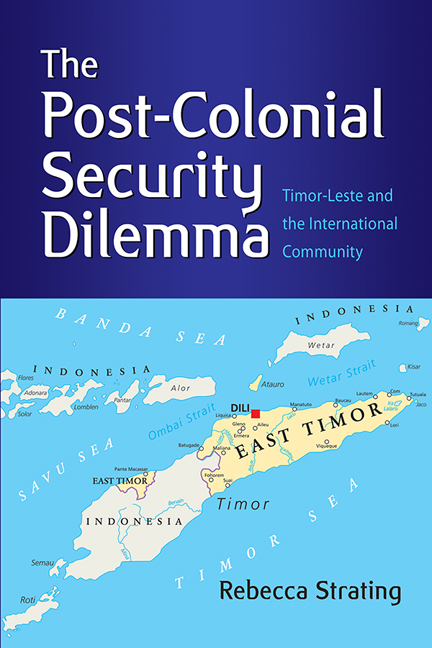Book contents
- Frontmatter
- Contents
- List of Tables
- Acknowledgements
- 1 Introduction
- 2 The Struggle for Recognition: Territorialization, Self-determination and the Imagining of “East Timor”
- 3 The Politics of Recognition: East Timor and the International Community
- 4 Establishing Legitimacy: International State-building in East Timor
- 5 Timor-Leste's Aspirational Foreign Policy
- 6 Identity Hedging: Timor-Leste's Engagement with Intergovernmental Organizations
- 7 Timor-Leste's National Security Agenda
- 8 Securing Economic Sovereignty
- 9 International Reconciliation and Transitional Justice
- 10 Conclusion: Timor-Leste in the Changing Regional Order
- Postscript
- Bibliography
- Index
- About the Author
- Frontmatter
- Contents
- List of Tables
- Acknowledgements
- 1 Introduction
- 2 The Struggle for Recognition: Territorialization, Self-determination and the Imagining of “East Timor”
- 3 The Politics of Recognition: East Timor and the International Community
- 4 Establishing Legitimacy: International State-building in East Timor
- 5 Timor-Leste's Aspirational Foreign Policy
- 6 Identity Hedging: Timor-Leste's Engagement with Intergovernmental Organizations
- 7 Timor-Leste's National Security Agenda
- 8 Securing Economic Sovereignty
- 9 International Reconciliation and Transitional Justice
- 10 Conclusion: Timor-Leste in the Changing Regional Order
- Postscript
- Bibliography
- Index
- About the Author
Summary
Australia and Timor-Leste signed the Timor Sea Maritime Boundary Treaty on 6 March 2018 in New York City. While the treaty resolved the symbolic issue of maritime boundary delimitation, no agreement was reached on a development concept for the shared resource, Greater Sunrise. In February, a leaked letter from Timor-Leste's lead negotiator Xanana Gusmão signalled his discontent with these negotiations as he blasted the independent oil and gas expert who had raised significant concerns around the commercial viability of Timor- Leste's pipeline plan and the assumptions built into Timor-Leste's economic modelling. Gusmão publicly declared that the pipeline was “non-negotiable”. The United Nations Compulsory Conciliation report released in April also confirmed that it had been unable to facilitate an agreement on the development concept for Greater Sunrise. The report outlined that Timor-Leste's proposal could only occur with a direct subsidy of US$5.6 billion by the government of Timor-Leste (or another funder), and it would only provide a mere 7 per cent return on a capital investment of US$15.6 billion.
By August 2018, a development deal for Greater Sunrise — the most critical resource for Timor-Leste's mid-term economic viability and functional sovereignty, and the centrepiece of its development agenda — remained elusive.
- Type
- Chapter
- Information
- The Post-Colonial Security DilemmaTimor-Leste and the International Community, pp. 339Publisher: ISEAS–Yusof Ishak InstitutePrint publication year: 2018

